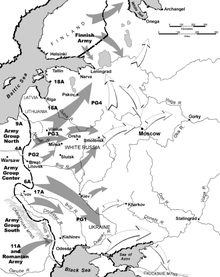Max Stotz
World War II Max Stotz (13 February 1912 – 19 August 1943) was an Austrian Luftwaffe military aviator during World War II, a fighter ace credited with shooting down 189 enemy aircraft claimed in more than 700 combat missions.
In 1935, he transferred to the Austrian Air Force and following the Anschluss, Austria's annexation into Nazi Germany, he served in the German Luftwaffe, initially with Jagdgeschwader 76 (JG 76—76th Fighter Wing) and later with Jagdgeschwader 54 (JG 54—54th Fighter Wing).
He flew his first combat missions in the Invasion of Poland and claimed his first aerial victory during the "Phoney War" period on the Western Front.
[2] Following the Anschluss, Austria's annexation into Nazi Germany on 12 March 1938, Stotz was accepted into the German Luftwaffe and became a pilot with 1.
[2][3] World War II in Europe began on Friday 1 September 1939 when German forces invaded Poland.
I. Gruppe of JG 76 participated in the invasion and returned to its home airfield at Wien-Aspern where it remained until end of October.
[4] On 5 November, Stotz received the Iron Cross 2nd Class (Eisernes Kreuz zweiter Klasse).
[5] The next day, he claimed his first aerial victory over a Royal Air Force (RAF) Bristol Blenheim bomber near Völklingen.
From Wengerohr, the unit flew combat air patrols in the area of Montmédy, Charleville-Mézières and Bastogne.
[7] In this action, Stotz claimed two Fairey Battle light bombers shot down over the Sedan combat area.
[9] This earned him the Iron Cross 1st Class (Eisernes Kreuz erster Klasse), awarded to him on 1 June 1940.
[13] Three days later, Stotz claimed his last aerial victory on the Western Front over a Blenheim bomber south of Rotterdam.
Gruppe was moved to an airfield at Kowno and was tasked with providing fighter escort for Panzer Group 4 advancing towards the Düna river.
[17] The next day, Stotz claimed his first aerial victory in this theater of operations over a Tupolev SB-2 bomber in the vicinity of Ostrov.
[18] On 7 August 1942, Stotz flew one of ten Bf 109s escorting a formation of Junkers Ju 88 bombers from Kampfgeschwader 3 (KG 3—3rd Bomber Wing) attacking the Soviet 6th and 8th Tank Corps at Sychyovka when they were intercepted by eight Yakovlev Yak-1 fighters from 32 IAP (32nd Fighter Aviation Regiment).
[27] On 21 February, Stotz flew as wingman of his Gruppenkommandeur (group commander), Major Hans Hahn.
During this mission, Hahn's aircraft suffered engine failure resulting in a forced landing behind enemy lines.
He succeeded Leutnant Emil Lang who had temporarily led the Staffel after Oberleutnant Alfred Teumer had been transferred in July.
[29] Following aerial combat on 19 August 1943 with a large formation of Yakovlev Yak-9 fighters in the vicinity of Vitebsk, Stotz bailed out of his Focke-Wulf Fw 190 A-6 (Werknummer 550 201—factory) 12 kilometres (7.5 miles) north of Kirov and went missing in action.
